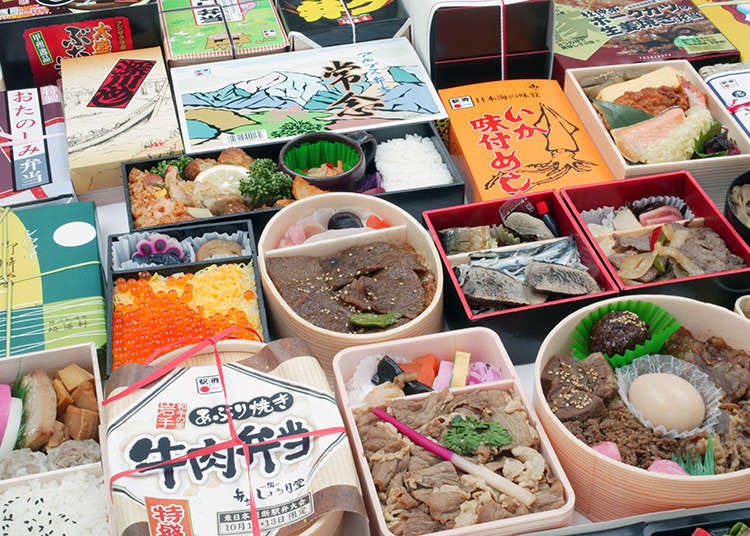
Train trips in Japan can range from short pleasant trips to long and adventurous rides. If you’re taking one of the longer trips, you might notice your stomach starting to grumble part of the way through. You don’t need to stress over making or carrying food around for a long time, though. If you're journeying by train in Japan, you shouldn't miss out on one of the best parts of the trip: the special lunches eaten on the train, known as ekiben. They have become a very important part of Japanese food culture as well. Find out about the history of these delicious, trouble-saving train bentos, and what makes them so special!
So: What’s an "Ekiben"?

An ekiben is a type of bento that is sold in train stations across Japan that travelers can eat on the train, particularly during long journeys.
The word ekiben is a combination of the Japanese words eki, meaning 'station', and bento, which you may already know as being a Japanese lunch box. An ekiben is a type of bento that is sold in large train stations across Japan, ergo the name eki bento, or ekiben for short. These bento boxes are known for their delicious and high quality ingredients, often featuring regional specialties of a particular area. For example, Tokyo offers many wonderful ekiben from some of the city's best shops, while places like Hokkaido offer an assortment of different seafood bentos, such as crabmeat, salmon roe, and rice-stuffed squid.
There is a wide variety of different types of ekiben, but regardless of what you choose you can expect a range of delicious Japanese dishes presented in a manner that is both beautiful and easy to eat. Unlike food at a restaurant, the time between ekiben preparation and consumption can vary. However, ekiben are specifically prepared with this in mind, and are typically meant to be eaten on the train, without needing to be warmed up. Food safety is also top priority, and expiration dates and times are clearly listed on each box, so that you can eat without worry.
A number of ekiben also come in unique packaging that you can save after use as a collector's item. One of the more popular reusable ekiben containers is shaped like a Japanese shinkansen, or bullet train. Others may feature popular characters from Japanese folklore, or even anime. Regular or collectable ekiben are generally more expensive than a bento you would purchase in a convenience store or supermarket, but because of the high quality ingredients and time they save you before your trip, they are considered to be well worth the extra cost.
Train Bentos Then and Now
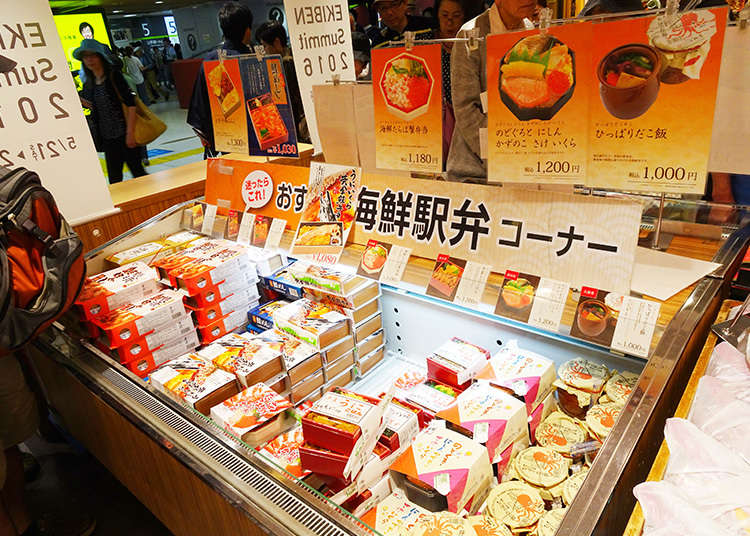
While there is some debate, many say that the origins of ekiben can be pinpointed to July 16, 1885, when onigiri (rice balls) were sold at Utsunomiya Station in Tochigi Prefecture. These onigiri were a simple lunch, containing just rice and pickled daikon radish pressed together and wrapped in bamboo leaves.
Since that time, ekiben began springing up in various train stations throughout Japan, offering a variety of dishes to suit the tastes of many hungry travellers.
What is it about ekiben that sets them apart from other bentos? The deliciousness of the food itself is certainly undeniable. However, the appeal of the ekiben is largely intangible. To really understand what is so special about ekiben, you must look to Japan’s past. At the time that ekiben were first being sold, the ubiquitous convenience stores of today did not exist. An ekiben offered a rare chance for travelers to try specialty foods from other areas that were not available in their home prefecture. The consideration of ekiben as rare, small luxury items is still widely held today. Even in the wake of international supermarkets and online shopping, an ekiben is still considered a special treat, and something that people look forward to buying during their travels. When taking a long trip, passengers may be on the train for several hours at a time, which means that bringing food to eat on the train is a must. An ekiben is the perfect meal to eat in this situation and very convenient. In fact, there is a saying that the scenery you see outside your train window adds a special spice to ekiben, which you cannot experience by eating any other kind of bento.
While some of the ekiben that you see today can be quite elaborate, their humble beginnings have not been forgotten: each July 16th, Utsunomiya Station holds an annual "Ekiben Anniversary" celebrating the history and heritage of this unique style of bento.
Long ago, ekiben were sold through train windows while the train was stopped, but these days you can find various ekiben stores and stalls in just about any major train station in Japan. Sometimes, ekiben can even be found in in special department stores, or supermarkets.
Recently, the ekiben fascination has spread outside of Japan to other countries. In March 2016, the East Japan Railway Company opened a limited time, pop-up ekiben shop at Paris railroad station, Gare de Lyon, in order to showcase Japanese food culture overseas.
What Exactly Do They Put in Ekiben?
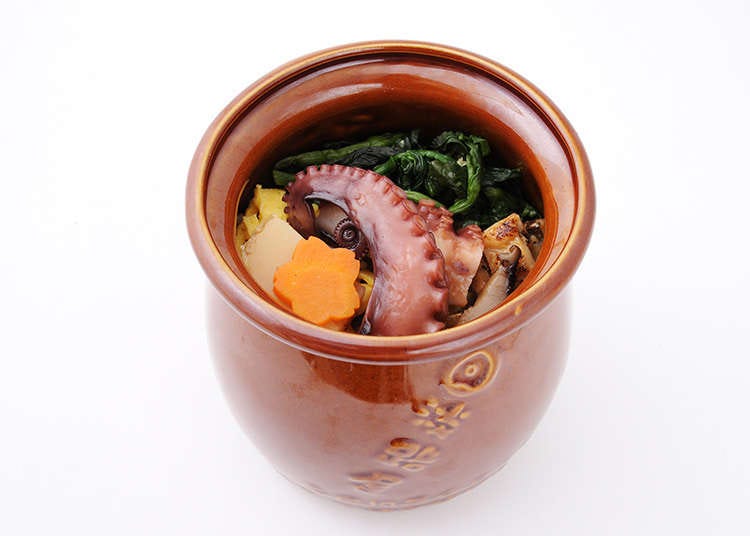
There is such a wide variety of ekiben, there seems to be an option for just about every taste and preference! The bentos can range from a simple, no-frills affair, to something more akin to a gourmet work of art than an on-the-go lunch. In addition to being tasty and nutritionally balanced, ekiben are also aesthetically pleasing, with a myriad of colors offering a feast to the eyes, something very characteristic of Japanese food culture. One great example of variety within a single ekiben is the Makunouchi Bento, which includes meat, fish, egg, vegetables, rice, and more.
As rice is a staple food in Japan, it's not surprising that it makes a frequent appearance in eki bentos, and in bentos in general. A typical ekiben is often a type of rice bowl, topped with seafood, meat, vegetables, or a combination of the three. With such a wide range of options available, the only problem is deciding which to choose!
Are there Train Bentos for People With Special Dietary Restrictions?
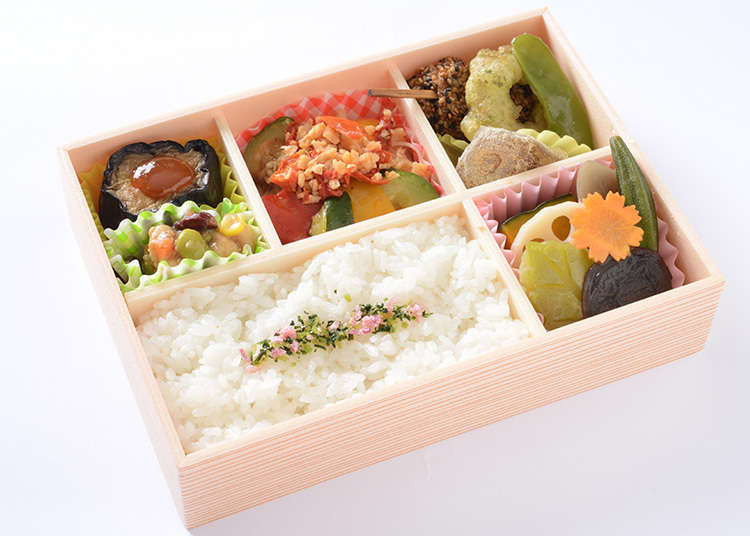
With the ever-growing number of tourists in Japan, and the expanding tastes of traveling customers, vendors have expanded their eki bento menus. They now create ekiben while keeping people with special dietary restrictions in mind. It is possible to find vegetarian, vegan, and halal options at select ekiben shops. However, keep in mind that these options may be more difficult to find than Japan’s more traditional varieties, so you may want to check beforehand with the shop staff if you have any concerns.
Everyday’s a Festival at Ekiben-ya Matsuri, Tokyo Station’s One-Stop Ekiben Shop
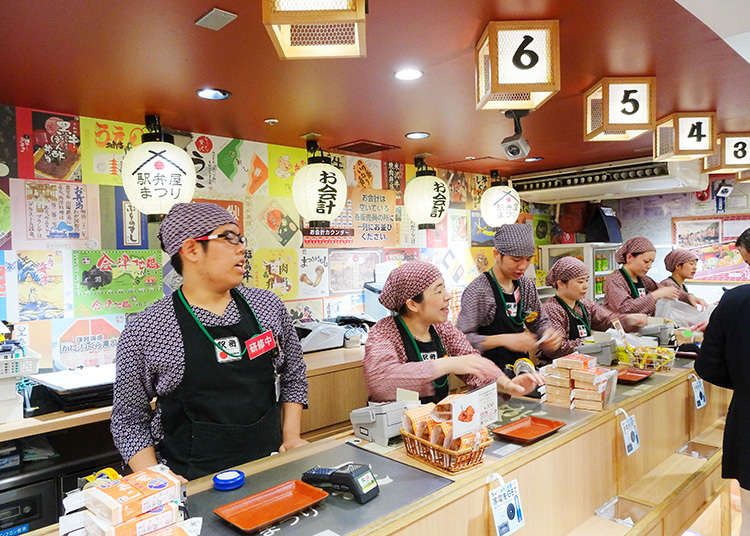
Hungry travelers can easily pick up the ekiben of their choosing by visiting the famous ekiben vendor, Ekiben-ya Matsuri, located on the first floor of the JR Tokyo Station. Inside the ticket gates. Ekiben-ya Matsuri offers over 170 kinds of ekiben each day, including specialty bentos from prefectures across Japan. An estimated number of 7,000 ~ 10,000 ekiben are sold at the shop each day!
From the early morning hours, you can find Ekiben-ya Matsuri bustling with customers trying to decide which of the many delectable bentos they will choose for lunch that day. Just outside the shop, you can spot a timetable displaying when certain bentos will be prepared, as well as a window where you can see bentos being created and put together right before your eyes.
The ekiben are divided by category: there is a section for meat bentos (containing things like pork cutlets, beef tongue, fried chicken, hamburger, etc.), one for sushi, and another for other types of seafood. There are other sections that feature a mix of ingredients, such as the previously mentioned Makunouchi Bento.
Whether you’re starting a long journey, or just riding a few stops away, if you’re in Tokyo Station, you shouldn’t miss the chance to try an authentic Japanese ekiben!
-
Ekiben-ya Matsuri駅弁屋祭
- Address 1-9-1 Marunouchi, Chiyoda, Tokyo 1st Floor Central Street (Inside the JR Tokyo Station ticket gates)
- Area
- Category
*Prices and options mentioned are subject to change.
*Unless stated otherwise, all prices include tax.
Popular Tours & Activitiess
-

Japan’s Shinkansen Is About to Change Travel in an Unexpected Way
by: Guest Contributor
-
Ad

(Opening in Jan 2026) 'THE SUMO LIVE RESTAURANT HIRAKUZA GINZA TOKYO!' 5 Exciting Ways to Experience the World of Sumo!
-

Strawberries, Style, and Tokyo’s Coolest Neighborhood: Winter Afternoon Tea in Kichijoji
by: Guest Contributor
-

First Japan Cherry Blossom 2026 Forecast Announced! Here's When & Where to See Sakura in Japan
-

This Winter, Godzilla Takes Over Haneda Airport
by: Guest Contributor
-
Ad

Complete Guide to Ueno's National Museum of Nature and Science, the Perfect Place to Visit on Rainy Days or With Children
Inspiration for Accommodations
-

Enjoy Mt. Fuji from the Comfort of Your Room! Recommended Ryokan with Mt. Fuji View
-

Stay Near the Cherry Blossoms! Hotels for Cherry Blossom Viewing in Tokyo
-

Family-Friendly Hotels with Free Shuttle to Disneyland: Convenient Access for a Magical Stay
-

Top Ranked Hakone Hotels with Mt. Fuji View: Enjoy Stunning Scenery from Your Private Space
-

Convenient Tokyo Hotels with Airport Shuttle: Ideal for Families and Heavy Luggage
-

Stunning Tokyo Tower View Hotels: Enjoy Spectacular Scenery from Your Private Space
-

Convenient Asakusa Hotels with Kitchens: Ideal for Extended Family Visits
-

Experience Luxury: Hakone's 10 Best Five-Star Accommodations
-

Enjoy Mt. Fuji Autumn Leaves! Top Hotels Near the Popular Autumn Leaves Corridor
-

Experience Hakone Fall Foliage from Your Room with Stunning Views
-

Ekiben Excellence: Japan's Most Fascinating Train Station Bentos!
-

Try Tokyo’s Brand-New Anime Bento, Sold at Samurai Hostel in Asakusa!
-

(Video) Walking Tour along Narita Omotesando - Quaint Historical Village near Narita Airport!
by: Victor Gonzalez
-

How to Make Bento for Beginners: 3 Big Rules and Easy Tips & Tricks! (Video)
-

Meiji Shrine (Meiji Jingu): Exploring the Sacred Sanctuary of Peace in Bustling Tokyo
-

Exploring Tokyo Station: 11 Must-Visit Spots Around the Heart of Tokyo
- #best ramen tokyo
- #what to buy in ameyoko
- #what to bring to japan
- #new years in tokyo
- #best izakaya shinjuku
- #things to do tokyo
- #japanese nail trends
- #what to do in odaiba
- #onsen tattoo friendly tokyo
- #daiso
- #best sushi ginza
- #japanese convenience store snacks
- #best yakiniku shibuya
- #japanese fashion culture
- #best japanese soft drinks


















